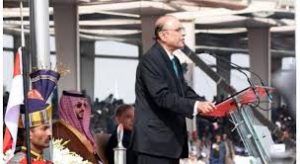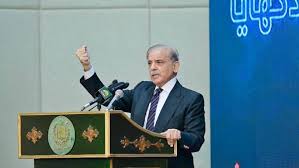Ancient tradition met modernity as King Charles III takes the throne
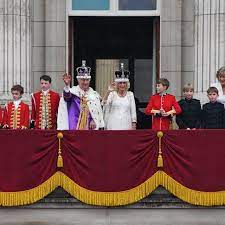
London: Britain’s King Charles III wearing the Imperial state Crown, and Britain’s Queen Camilla wearing a modified version of Queen Mary’s Crown talk while viewing the Royal Air Force fly-past on the balcony of Buckingham Palace following the coronation in London on May 6, 2023.
Britain’s King Charles III wearing the Imperial state Crown, and Britain’s Queen Camilla wearing a modified version of Queen Mary’s Crown talk while viewing the Royal Air Force fly-past on the balcony of Buckingham Palace following the coronation in London on May 6, 2023. | Photo Credit: Getty Images
Ancient tradition met modernity on Saturday, when Britain’s King Charles III was crowned at Westminster Abbey in a two-hour ceremony that was watched by millions of Britons and many more across the world. The constitutional monarch formally ascended the throne at the age of 74, as titular head of the U.K. and 14 former commonwealth countries.
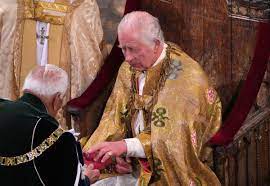
Charles’s ascension to the throne is in sharp contrast to his mother’s. Queen Elizabeth II became queen in 1953 at the age of 25, as countries of the former British Empire were freeing themselves from their colonial past, and Britain occupied a more central role in the world.
Some 70 years later, on a characteristically wet and overcast English spring morning, the king, looking solemn as he travelled with the Queen Consort, Camilla, in a stage coach drawn by six ‘Windsor Greys’, arrived at a packed Abbey — which saw its first coronation in 1066.
Also read: King Charles III’s coronation ceremony live updates | Charles III crowned King at first U.K. coronation in 70 years
In attendance were his extended family, friends, those involved with volunteering (one of the king’s pet causes), as well as heads of state and government.
India was represented at the weekend’s events by Vice-President Jagdeep Dhankhar and wife Sudesh Dhankhar. French President Emmanuel Macron and First Lady Brigitte Macron, and U.S. First Lady Jill Biden were also present.
Prime Ministers of Commonwealth “realms”, of which the British monarch is the head of state, also attended Saturday’s coronation.
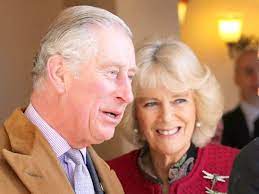
Notably, the King’s younger son, Prince Harry, who recently had a falling-out with his family over allegations about their treatment of his wife Meghan Markle, and the publication of his memoirs, had flown in from California to attend the coronation.
The ceremony was deeply historical in many respects, but the signs of modernity — and diversity — were unmistakable. For the first time, the Prime Minister of the U.K. is a south Asian man. Rishi Sunak, who is a Hindu, read from the Bible. The Scottish First Minister, a south Asian and Muslim Briton, wore a kilt to event. There was a Black gospel choir and female bishops, and a Welsh song opened the ceremonies.
King Charles III holds the Sovereign’s Ring, also called the Coronation Ring, during his coronation ceremony in Westminster Abbey in London on May 6, 2023.
King Charles III holds the Sovereign’s Ring, also called the Coronation Ring, during his coronation ceremony in Westminster Abbey in London on May 6, 2023. | Photo Credit: Getty Images
Some of these diverse elements were designed to reflect the King’s personal preferences. In the 1990s, Charles had wanted to be styled ‘Defender of Faith’ rather than ‘Defender of the Faith’, the traditional epithet for British monarchs. To reflect this sentiment, the King received coronation regalia from individuals symbolising Britain’s different religions.
As has been the practice for centuries, the King was anointed with holy oil by the Archbishop of Canterbury before he was crowned. Charles was seated on the throne of Edward the Confessor, used at every coronation since 1300 and was crowned by the Archbishop of Canterbury, to cheers of “God Save the King”.
After some members of the clergy and royal family pledged allegiance to the King, the public was invited to do so if they wished. This new element to the coronation created some controversy in recent days, with critics pointing to its unsuitability for modern times.
One of the themes of the coronation was the monarch as an instrument of service. However, the ground realities are more complex. Just over a quarter of adult Britons (26%) surveyed by YouGov in April said they would prefer to have an elected head of state, while 60% said they supported the monarchy.
“Our Head of State is a very important position and it should be decided democratically and not depend on which uterus you happen to come out of,” a protester, Stephen Purse, a member of the anti-monarchy group Republic, said. The group’s leader, Graham Smith, as well as other demonstrators were detained on Saturday.
The Queen Consort, Camilla, was also crowned on Saturday — after having traversed a long and tumultuous — and ultimately successful — path to the throne. She wore Queen Mary’s Crown, first used in 1911, officially for “sustainability and efficiency” reasons, but as per reports, also out of sensitivity that using the crown with the Kohinoor diamond — seen by many as a symbol of a painful colonial past — would be offensive, especially to those in India.
King Charles III and Queen Camilla travel in the Gold State Coach back to Buckingham Palace following their coronation in London on May 6, 2023.
Coronation celebrations are scheduled for the next two days — with a Coronation concert, community and volunteer events on Sunday as well as Monday, which have been declared a U.K-wide holiday.

